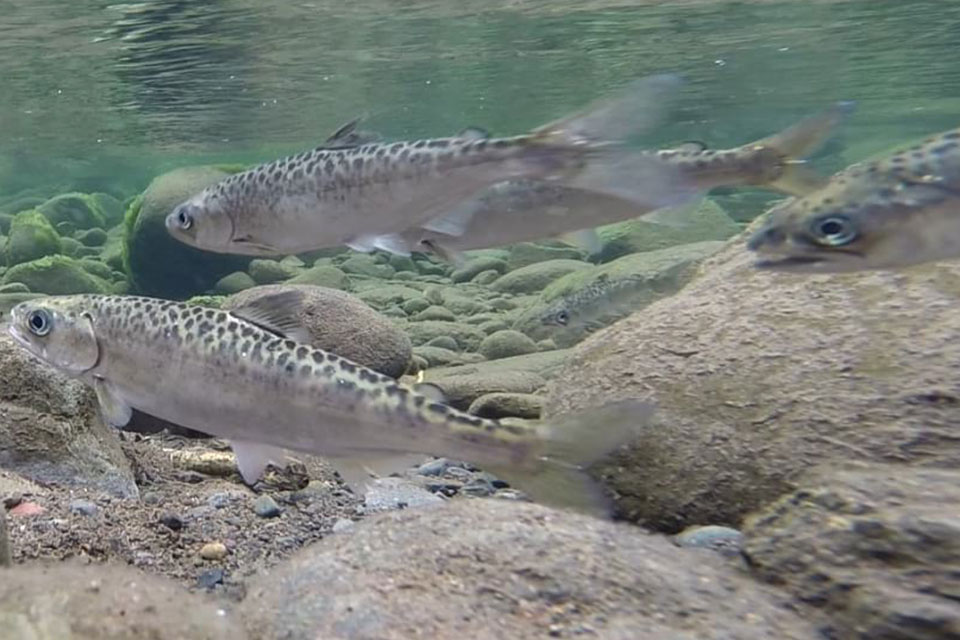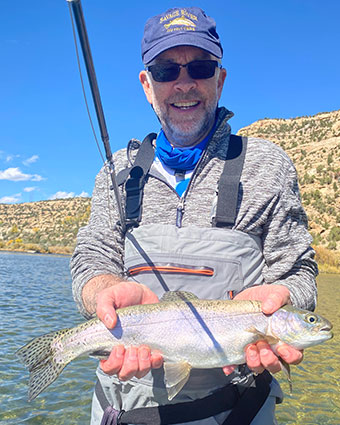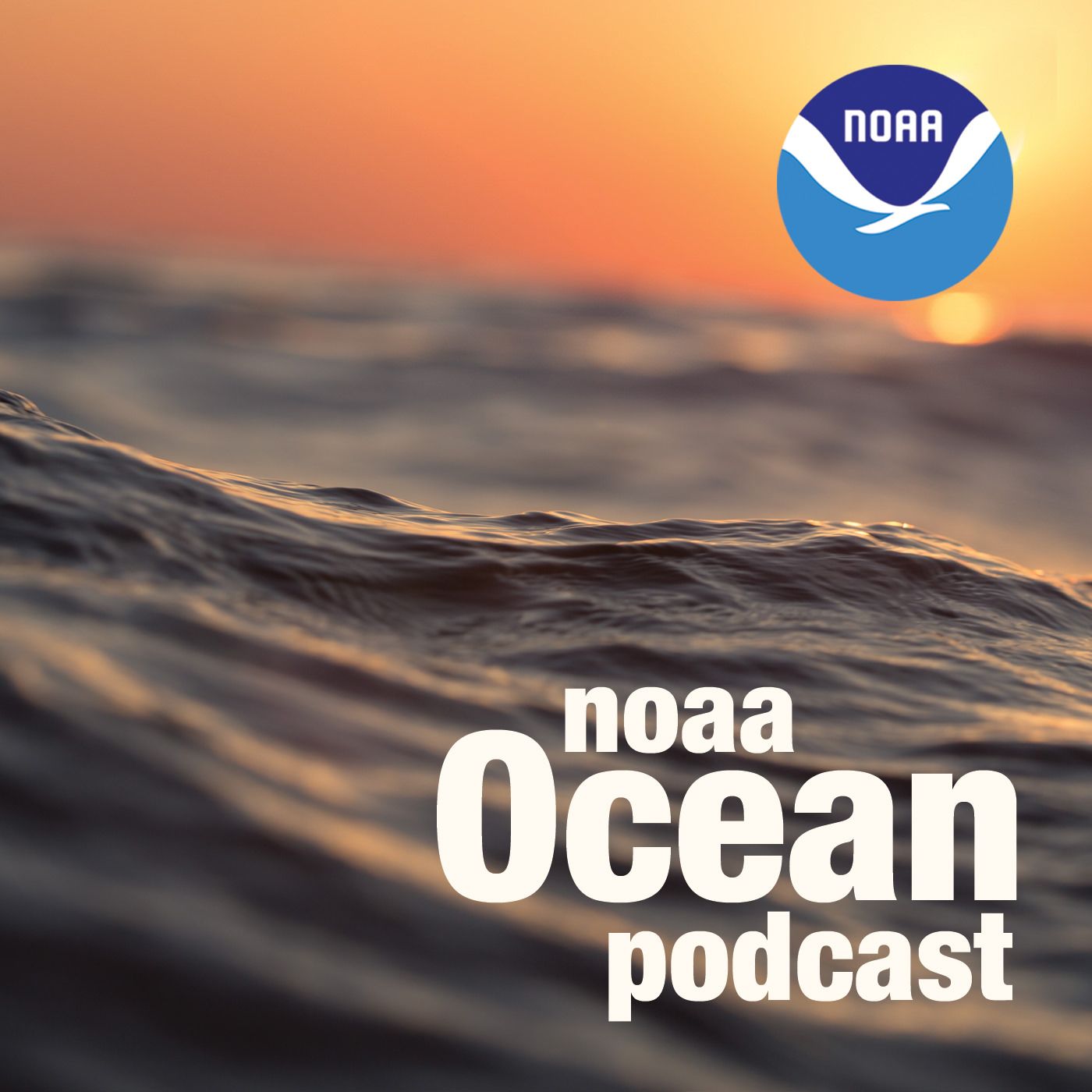Restoration: Replacing What Was Lost
NOAA Ocean Podcast: Episode 50
When pollution harms our waterways from single events like oil spills or from industrial sites over a span of decades, the cleanup phase is just the beginning. Ultimately, through a process that can take years to decades, settlements are reached with the parties that caused the pollution to fund restoration projects. The goal: to put back what was lost. In this episode, learn how good things like restoration can come from bad things like oil spills and superfund sites.

The Lower Duwamish River in Seattle and Port Angeles Harbor on the Puget Sound were both sites of hazardous waste pollution. Migratory salmon, which are spawned in freshwater rivers but migrate to the ocean where they spend most of their life, were harmed by contaminants and industrialized shorelines. This also impacted local Native American Tribes for whom salmon have enormous cultural value. In 2021, NOAA worked together with tribal partners to reach settlements for the Puget Sound and Lower Duwamish River and will continue to collaborate on projects that benefit salmon and coastal habitats in Washington. This was one of many settlements during fiscal year 2021. All told, NOAA recovered over $130 million to restore 10 polluted waterways after oil spills and industrial pollution.
Listen here:
Or listen in your favorite podcast player:
Transcript

Tom Brosnan, shown here fly fishing in New Mexico, is an environmental scientist with NOAA’s Office of Response and Restoration (OR&R). In addition to Tom's science role, his daily duties include planning, budgeting, and communications for OR&R's Assessment and Restoration Division.

Tom Brosnan, shown here fly fishing in New Mexico, is an environmental scientist with NOAA’s Office of Response and Restoration (OR&R). In addition to Tom's science role, his daily duties include planning, budgeting, and communications for OR&R's Assessment and Restoration Division.
HOST: This is the NOAA Ocean podcast, I’m Troy Kitch. If you lived in Santa Barbara, California, back in 2015 I’m sure you remember the oil spill that year. About 100,000 gallons of oil spilled from a burst pipeline near Refugio State Beach. National news showed cleanup crews removing heavily oiled sand and dirt from the coastline, where thick crude oil covered rocks and cormorants and pelicans covered in oil washed ashore. The pollution from the spill closed off beach and park access for a month.
But today we’re not going to focus on what happens during the initial cleanup when there are big pollution events along our waterways. We’re going to talk about what happens next.
Because the thing is, when pollution harms our waterways from single events like the oil spill in Santa Barbara or from industrial sites over a span of decades, the cleanup phase is just the beginning. Ultimately, through a process that can take years to decades, settlements are reached with the parties that caused the pollution. And this money is used to fund restoration projects. The goal: to put back what was lost.
Our guest today explains how this process works, NOAA’s role, how these decisions are made, and why we do this.
We’re joined by Tom Brosnan, an environmental scientist with the Assessment and Restoration Division of NOAA’s Office of Response and Restoration. Tom has been with NOAA for over 20 years working with teams who investigate the damages that occur in polluted places, and draw up plans to restore these areas with projects that are carefully tailored to address the damage caused at each location.
Tom thanks for joining us today. Let’s start with why we the U.S. government does restoration work.
TOM BROSNAN: I think what’s unique about this whole field is it’s backed by what is known as the public trust doctrine. And this is handed down from Roman times, which basically states that the public collectively owns certain natural resources. And once those resources are impaired, the public is owed compensation. And under these laws, the Oil Pollution Act, the Superfund, and others, that compensation to the public is via restoration projects. The public have suffered a loss, they need to be compensated for that loss, and that compensation is in the form of restoration of those resources that were impaired in the first place, which they own.
HOST: Can you talk a bit about what you mean when you say ‘resources?’
TOM BROSNAN: “Our scientists and economists work with our partners across the country to assess what public natural resources have been affected by pollution. Resources such as fish, birds, sea turtles, and dolphins, as well as the habitats that they rely on. We also assess lost human uses of those resources. For example, impacts to fishing or swimming, or bird watching. And then we work with our partners to create restoration projects that will offset impacts to those resources.
HOST: Walk us through the process at a high level so we get a sense of how this all works. So there is some sort of environmental disaster or damage that occurs. Let’s start there. What comes next?
TOM BROSNAN: “When there’s an oil spill or a hazardous release, there’s actually a regulatory framework in place to deal with that. First, there’s typically a response, which is led by, for example, the U.S. Coast Guard or the U.S. EPA, and state agencies, and the goal of that response is usually to control, contain, and clean up the release. And concurrently, trustee agencies like NOAA begin to assess what public natural resources were impacted and to what degree. Then we determine the appropriate type and amount of restoration needed to offset that loss. We put that out for public comment in a restoration plan, and then secure the funding for the restoration from those that are responsible for the pollution via a legal agreement. And then typically NOAA and/or its trustee partners will implement and monitor the restoration projects, although in some cases the responsible party will implement the project with trustee oversight.
HOST: And who else is involved with this? Is it just NOAA?
TOM BROSNAN: “Within NOAA, we work with experts within the NOAA Restoration Center to craft and implement our restoration projects and attorneys with our General Counsel of natural resources to guide us through the legal process. Beyond NOAA, we work with response agencies to share the data. Also with our co-trustees such as the Department of the Interior and state agencies and tribes. And we also seek input from the public. We also often work cooperatively with those responsible for the pollution. And finally, we work with the U.S. Department of Justice to create a legal agreement, or to pursue those responsible for the pollution in court.
HOST: There may be a variety of potential restoration activities that may be considered for a given site. How do you make these decisions about what to do?
TOM BROSNAN: “The type and amount of restoration required to compensate the public is case specific and will vary depending on what resources were injured or lost and to what degree. So given that, in over 300 settlements over the past 30 plus years, restoration funds have been used to restore critical habitats nationwide like wetlands and beaches, mangroves, rivers, and sea grasses, as well as oysters and coral reefs, and to remove blockages to fish migration on many miles of stream. Restoration has also targeted specific living resources like fisheries, and birds, sea turtles, and marine mammals. And restoration funds have also been used to restore recreational uses such as fishing, boating, and swimming, via boat ramps, fishing piers, and improved access. It really is site and case specific. We are trying to restore what was lost, and typically we are trying to do that in kind and in place.
HOST: What do you mean by in kind and in place?
TOM BROSNAN: “In kind means to restore the actual habitats and/or natural resources, or the services that they provide, matching that as closely to what was injured. In place means we would like to provide that restoration where the impact occurred — that is not always possible due to a variety of factors — but it is our preference where possible to do things that are in kind and in the same area.
HOST: In 2021, the government recovered over 130 million dollars in settlements for 10 polluted waterways around the nation. Is that typical for a year?
TOM BROSNAN: “It’s hard to say what is a typical year. In any given year, we might have a couple of settlements to over a dozen. But settlements in 10 polluted waterways is certainly on the high side. Settlements can take many years to be finalized and require many parties to agree. So we are very pleased to have so many settlements this year, in 2021, because it will yield significant restorations in these waterways in the years to come.
HOST: How many other restoration cases are still underway now, in late 2021?
TOM BROSNAN: “Currently there are over 40 cases where we are actively assessing injuries and pursuing a resolution and restoration. And NOAA also has over 70 cases where we are working with our partners to actually implement restoration on settled cases.
HOST: So these cases in 10 waterways that reached settlement in 2021, can you tell us a bit about a few of them? Let’s start with Santa Barbara, California.
TOM BROSNAN: “Sure. In California, there was a settlement in 2021 that included 22.3 million dollars for restoration to compensate for a 2015 oil spill at Refugio Beach. Birds, marine mammals, shoreline habitat, and underwater habitats, as well as human uses of beaches and parks were all negatively affected by that oil spill, and the 22.3 million dollars will be used to restore and offset for those losses.
HOST: Where to next?
TOM BROSNAN: “The Lower Duwamish River is an urbanized estuary in Seattle, Washington, and it’s been contaminated by a variety of toxic chemicals from many sources since at least the early 1900s. And these persistent contamaminants have accumulated in sediments and fish and shellfish, advisories have been issue against the consumption of fish and shellfish that live there year round, and it was designated as a Superfund site in 2001. So while the cleanup of the Lower Duwamish River has begun, and will continue for many years, cleanup alone will not restore the salmon and other resources that have been impacted by past contamination. That’s going to require the creation of additional habitat — habitat that’s currently scarce in that area. Trustees have had several settlements with different parties to date, including two in 2021 that yielded 51.5 million dollars for restoration of habitats that will benefit fish and wildlife, threatened fish species such as the Puget Sound chinook salmon and the Puget Sound steelhead. And the young of these species spend time in this part of the Lower Duwamish River as they transition from freshwater to saltwater. And restoration will directly benefit this sensitive life stage by providing critical habitat that is in short supply.
HOST: Let’s do one more.
TOM BROSNAN: “In Michigan, 25 million dollars was obtained for partial restoration of the Kalamazoo River which was injured by the release of chemicals knows as PCBs from paper mills in the late 1950s to the early 1970s. These releases contaminated sediments, water, and flood plains and adversely affected the health of fish, wildlife, as well as human uses of those resources. And initial restoration projects will include dam removals, land conservation, and enhancement of riverine shoreline habitats.
HOST: A quick note to listeners — check our show notes for a link to a story on our website that accompanies this podcast where you can get the details on all of the 2021 settlements, along with some great photos that you don’t want to miss. Tom, something that strikes me about restoration projects is how they’re about restoring wildlife and habitats, but also about benefiting people.
TOM BROSNAN: “Well these natural resource managed settlements really are an engine for coastal restoration. And these funds are by law, when they’re secured by a settlement, they have to go towards the restoration of the resources that were injured and they can be very impactful in an area. This is especially true when settlement funds are leveraged with other funds from partners to create even more restoration. For over 30 plus years, NOAA and its partners have secured over 10.5 billion dollars to restore critical coastal habitats, and fisheries, endangered species and outdoor recreation impacted by pollution all around the country. These restoration projects also provide economic benefits to local communities, including underserved and indigenous localities which are often disproportionately affected by pollution. These economic benefits stem from robust fisheries, tourism, marine jobs, and coastal resilience. And these restoration efforts align with the concept of a blue economy, that is: promoting the sustainable use of healthy coastal resources.
HOST: So what would be the one thing you’d want listeners to take away from our conversation?
TOM BROSNAN: “I guess it’s that good things like restoration can actually come from bad things like oil spills and superfund sites. And we have laws and we have agencies in place that are doing exactly that: they’re tackling these really bad events, these pollution events, and working hard to figure out how to put back what was lost.
HOST: Tom Brosnan is a scientist with the Assessment and Restoration Division of NOAA’s Office of Response and Restoration. If you’re interested in what sort of work is being done in polluted waterways in the coastal state where you live, check our show notes to the link to NOAA’s Damage, Assessment, Remediation, and Restoration Program and the Response and Restoration office which is part of the National Ocean Service. You’ll also find these links in our accompanying story, which is also in our show notes. And this has been the NOAA Ocean Podcast. We’ll be back soon with another episode.

From corals to coastal science, connect with ocean experts to explore questions about the ocean environment.
Social